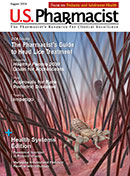According to results from a study published in the journal Gynecologic Oncology, the use of maintenance therapy is expanding for patients with platinum-sensitive, recurrent ovarian cancer, regardless of biomarker status. Researchers conducted a retrospective study of patients in a U.S. database, including 2,292 patients with recurrent ovarian cancer who had received second- or third-line platinum-based chemotherapy.
In the study, 222 patients had completed chemotherapy and had at least 2 months of active surveillance (n = 78) or received maintenance therapy with a poly[ADP-ribose] polymerase (PARP) inhibitor or bevacizumab (n = 147). At baseline, the patients' average age was 66.1 years; 69% were Caucasian, and 6% were of Hispanic or Latina ethnicity. Breast cancer gene (BRCA) mutations were present in 20% of patients, 59% had wild-type BRCA, and 21% of patients had unknown BRCA status.
The majority of patients with BRCA mutations (63%) received a PARP inhibitor, 17% received bevacizumab, and 20% underwent active surveillance; the PARP inhibitor prescribed most often was olaparib (26%), followed by niraparib (24%) and rucaparib (13%). Among patients with wild-type BRCA, 40% received a PARP inhibitor, 36% underwent active surveillance, and 23% received bevacizumab; the PARP inhibitor prescribed most often was niraparib (21%), followed by olaparib (10%) and rucaparib (9%). Among patients with unknown BRCA-mutation status, 45% underwent active surveillance, 43% received a PARP inhibitor, and 13% received bevacizumab; the PARP inhibitor prescribed most often was niraparib (28%), followed by olaparib (13%) and rucaparib (2%).
It was found that younger patients were more likely to receive maintenance therapy compared with patients older than age 75 years. Among patients who underwent active surveillance, 32% were older than age 75 years.
The authors determined that the use of PARP inhibitors increased by an average of 1.3% every 3 months (P = .02), and the use of active surveillance decreased by an average of 1.8% (P <.01). There was no significant shift in the use of bevacizumab (P = .22). The authors noted, "Additional follow-up is needed to understand the impact of different maintenance strategies in real-world settings on survival outcomes and quality of life and assess how the integration of PARP [inhibitors] in the frontline setting will impact treatment patterns in the recurrent setting."
The authors concluded that, in their real-world population study, maintenance therapy is becoming progressively more widespread following second- or third-line platinum-based chemotherapy regardless of biomarker status. They also noted that these results provide greater understanding into shifting treatment patterns for patients with recurrent ovarian cancer.
The content contained in this article is for informational purposes only. The content is not intended to be a substitute for professional advice. Reliance on any information provided in this article is solely at your own risk.
« Click here to return to Oncology Update.
Published September 21, 2021





